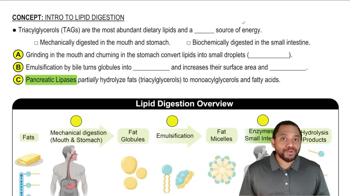Palm oil has a high level of glyceryl tripalmitate (tripalmitin). Draw the condensed structural formula for glyceryl tripalmitate.
<IMAGE>
 Verified step by step guidance
Verified step by step guidance Verified video answer for a similar problem:
Verified video answer for a similar problem:



 2:5m
2:5mMaster Glycerophospholipids Concept 1 with a bite sized video explanation from Jules
Start learning